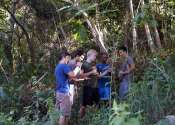The Smithsonian Tropical Research Institute (STRI) in Panama, the only bureau of the Smithsonian Institution based outside of the United States, is dedicated to understanding biological diversity. What began in 1923 as a small field station on Barro Colorado Island in the Panama Canal Zone has developed into one of the world's leading research institutions. STRI’s facilities provide a unique opportunity for long-term ecological studies in the tropics, and are used extensively by some 600 visiting scientists from academic and research institutions in the United States and around the world every year. The work of resident scientists has allowed STRI to better understand tropical habitats and has trained hundreds of tropical biologists.
- Website
- http://www.stri.org/
- Wikipedia
- http://en.wikipedia.org/wiki/Smithsonian_Tropical_Research_Institute
Some content from Wikipedia,
licensed under CC BY-SA
Subscribe to rss feed









